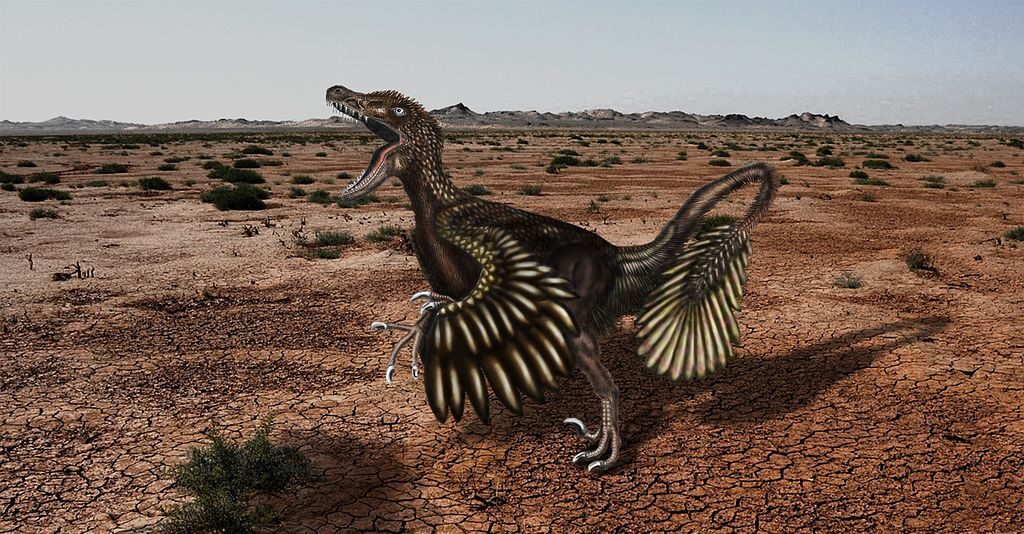Across the ancient landscapes of our planet, dinosaurs once thundered in massive herds, leaving behind only their fossilized footprints as evidence of these dramatic events. These trace fossils, preserved in stone for millions of years, provide paleontologists with a remarkable window into dinosaur behavior that skeletal remains alone cannot offer. Unlike bones, which reveal information about anatomy and evolution, footprints capture moments in time, showing how dinosaurs moved, interacted, and responded to threats as living, breathing animals. In recent decades, the study of dinosaur trackways has evolved into a sophisticated science, with several remarkable sites around the world preserving evidence of what appear to be prehistoric stampedes. These fossilized moments of panic and coordinated movement are revolutionizing our understanding of dinosaur social behavior, herd dynamics, and predator-prey relationships in the Mesozoic era.
The Science of Paleoichnology: Reading Ancient Footprints

Paleoichnology, the study of trace fossils including footprints, has become an essential complement to traditional paleontology in understanding dinosaur behavior. Unlike skeletal remains, which typically represent an animal’s final moments, trackways capture dinosaurs in action—walking, running, hunting, or fleeing. Scientists analyze the depth, spacing, and orientation of footprints to determine an animal’s size, speed, and direction of travel. The preservation of footprints requires very specific conditions: the dinosaur must step on a surface soft enough to record its foot shape but firm enough to maintain the impression until it can be covered by sediment and eventually fossilized. This delicate balance of circumstances makes well-preserved trackways particularly valuable to researchers, especially when they contain evidence of multiple animals moving together, potentially in response to a threat.
Defining a True Dinosaur Stampede

Not every collection of dinosaur footprints constitutes evidence of a stampede, and paleontologists apply strict criteria when making such interpretations. A true stampede trackway typically shows a sudden change in direction or speed across multiple individuals, suggesting a coordinated response to danger. The footprints often display deeper heel strikes and elongated toe marks, indicating animals running at high speeds rather than walking leisurely. Spacing between tracks usually increases dramatically, reflecting longer strides as dinosaurs accelerated. Scientists also look for evidence of smaller individuals being positioned in the center of the group with larger, presumably adult dinosaurs at the perimeter—a protective formation observed in modern herding animals. These characteristics help researchers distinguish between normal migratory movement and genuine panic responses preserved in stone.
The Lark Quarry Dinosaur Trackways: Most Famous Stampede Evidence
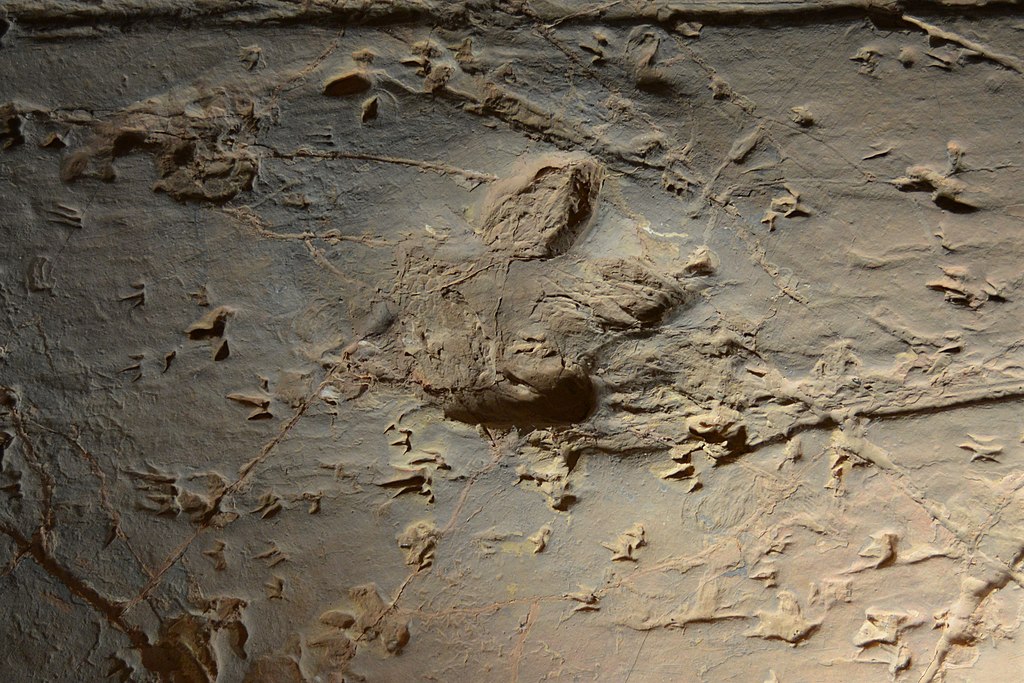
The Lark Quarry Conservation Park in Queensland, Australia, houses what was long considered the most compelling evidence of a dinosaur stampede ever discovered. Dating back approximately 95 million years to the mid-Cretaceous period, this remarkable site preserves nearly 3,300 footprints from small to medium-sized dinosaurs, apparently fleeing in terror. The traditional interpretation suggested these tracks recorded a moment when a large theropod predator (possibly a species similar to Allosaurus) approached a water source where smaller dinosaurs were gathered, triggering a chaotic flight response. The smaller tracks show evidence of rapid acceleration and direction changes consistent with panic behavior. However, recent reanalysis has sparked debate among paleontologists, with some suggesting the tracks may instead represent dinosaurs crossing a river rather than fleeing a predator. This ongoing scientific conversation demonstrates how trace fossil interpretation continues to evolve with new analytical techniques.
The Holy Trinity Dinosaur Track Site: Evidence of Group Behavior

Located in La Rioja, Spain, the Holy Trinity dinosaur track site contains over 5,000 footprints spanning multiple dinosaur species and has yielded important insights into herd dynamics. Dating to the Early Cretaceous period, approximately 125 million years ago, this site preserves evidence of both carnivorous and herbivorous dinosaurs moving in coordinated groups. Of particular interest are parallel trackways of similar-sized ornithopod dinosaurs, suggesting these plant-eaters traveled together in age-segregated herds. Some sections of the trackways show a sudden alignment of direction and increased pace across multiple individuals, potentially indicating a response to perceived danger. The consistent depth and orientation of these prints suggest the animals were moving as a coordinated unit rather than as scattered individuals, providing compelling evidence for sophisticated social behavior among dinosaurs long before mammals evolved complex herding strategies.
The Paluxy River Trackways: Predator-Prey Interactions
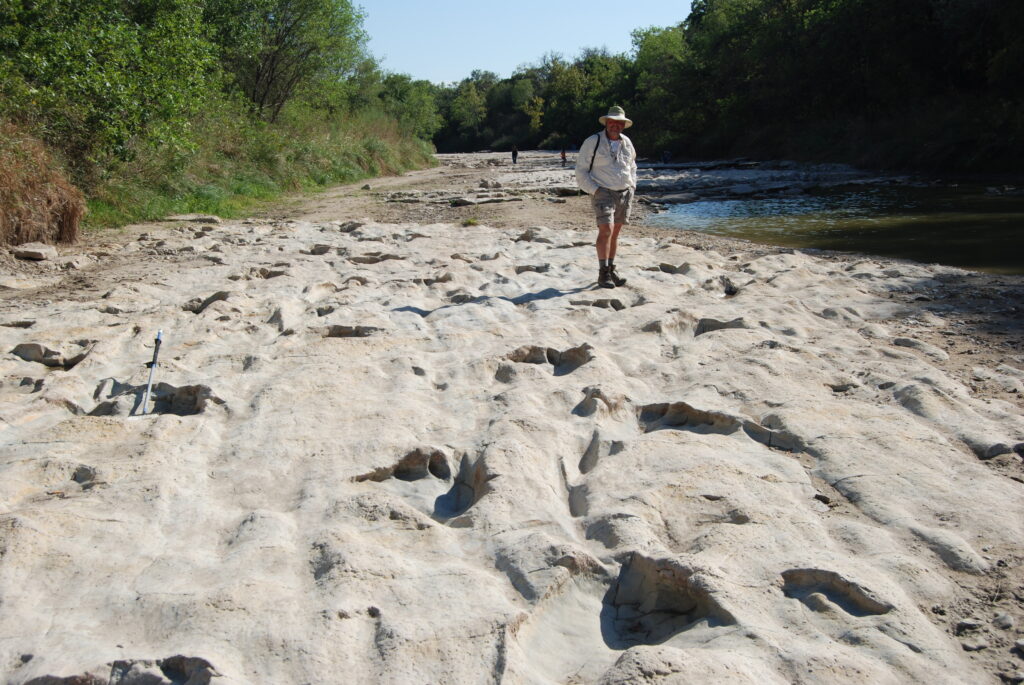
The Paluxy River trackways in Dinosaur Valley State Park, Texas, contain some of the most dramatic evidence of potential predator-prey interactions during the Early Cretaceous period, approximately 113 million years ago. These limestone beds preserve footprints of both large theropod dinosaurs (likely Acrocanthosaurus) and sauropods (possibly Sauroposeidon or Paluxysaurus), with some trackways appearing to show predators following potential prey. One famous sequence shows theropod footprints directly overlapping sauropod tracks, which some researchers have interpreted as evidence of active hunting behavior. Other sections reveal what might be defensive herding formations among sauropods, with smaller individuals clustered between larger adults as they moved across the ancient mudflats. While paleontologists debate whether these trackways represent active hunting or coincidental crossing of paths, they nonetheless provide rare glimpses into the dynamic interactions between different dinosaur species.
How Footprint Analysis Reveals Dinosaur Running Speeds

Trackways from apparent stampedes provide unique opportunities to calculate maximum running speeds for dinosaur species that might otherwise be estimated only through skeletal proportions. Paleontologists use a formula relating stride length to leg length and movement frequency to estimate velocity from fossilized footprints. During a stampede, dinosaurs would likely be moving at or near their maximum speeds, making these trackways particularly valuable for understanding locomotor capabilities. Analysis of ornithopod trackways from stampede sites suggests some medium-sized dinosaurs could reach speeds of up to 25-30 miles per hour when fleeing, comparable to modern ungulates like deer or antelope. Larger dinosaurs like adult sauropods show less dramatic increases in speed during apparent panic events, consistent with biomechanical models suggesting their massive size limited rapid acceleration. These calculations help paleontologists understand not just how dinosaurs moved, but also predator-prey dynamics and escape strategies in prehistoric ecosystems.
Herd Composition Revealed Through Footprint Size Variation

Stampede trackways often preserve footprints from multiple individuals of varying sizes, offering valuable insights into the age structure of dinosaur herds. By measuring hundreds of footprints at sites like the Davenport Ranch trackways in Texas, scientists can identify distinct size clusters representing different age groups within a species. Many herbivorous dinosaur trackways show a trimodal distribution of footprint sizes, suggesting herds comprised juveniles, subadults, and full-grown individuals traveling together. This pattern mirrors social structures seen in modern elephants and other large mammals, where family groups include multiple generations. The presence of very small footprints alongside adult-sized tracks indicates that even young dinosaurs participated in group movements and stampedes, rather than being left in nests or separate nursery groups. Some trackways also reveal that during panic events, juveniles often moved toward the center of the group, suggesting adults may have actively protected younger herd members from threats.
The Triggers Behind Prehistoric Stampedes

While the footprints themselves preserve the dinosaurs’ responses, determining what triggered ancient stampedes requires careful contextual analysis and often involves some speculation. In some cases, trackways preserve direct evidence of potential causes, such as the large theropod tracks approaching smaller dinosaur prints at Lark Quarry. Predator attacks remain the most obvious trigger for sudden mass movement, a pattern consistent with behavior observed in modern herding animals. Environmental factors may have also played significant roles, with evidence at some sites suggesting dinosaurs fled from rising water levels, approaching wildfires, or volcanic activity. The Maragua Syncline trackways in Bolivia show dinosaurs moving rapidly away from what would have been an active volcanic zone during the Late Cretaceous. Volcanic ash preserved alongside some trackways further supports the hypothesis that environmental catastrophes, not just predators, could trigger mass dinosaur movements preserved as apparent stampedes in the fossil record.
Comparing Dinosaur Stampedes to Modern Animal Behavior

Analyzing dinosaur stampede evidence alongside observations of living animals provides valuable context for interpreting prehistoric behavior patterns. Modern herding animals like wildebeest, buffalo, and elephants display remarkably similar stampede dynamics to those preserved in dinosaur trackways. These include coordinated directional movement, size-segregated positioning with vulnerable young protected in the center, and consistent spacing between individuals even at high speeds. Studies of zebra and wildebeest stampedes in the Serengeti show that herds maintain social cohesion even during panic events, with related individuals staying closer together—a pattern potentially mirrored in some dinosaur trackways where certain footprint sizes cluster together. Unlike mammals, however, dinosaur trackways sometimes show evidence of multiple species fleeing together, suggesting mixed-species herding or at least shared threat responses across different dinosaur types. These comparisons help paleontologists distinguish between behaviors unique to dinosaurs and those that represent fundamental adaptive strategies for large terrestrial vertebrates facing predation pressure.
Controversial Interpretations and Ongoing Debates

The interpretation of dinosaur trackways as evidence of stampedes remains subject to scientific debate, with alternative explanations challenging traditional narratives. The Lark Quarry site, long hailed as a classic stampede example, has been reinterpreted by some researchers as showing dinosaurs wading across a river rather than fleeing a predator. They point to evidence of water flow direction in the sediments and argue that the varying depths of footprints reflect different water depths rather than running speeds. Similarly, some trackways previously described as stampedes may represent normal migratory movements or daily travel between feeding and watering areas. Distinguishing between routine movements and genuine panic responses requires careful analysis of multiple lines of evidence, including footprint morphology, stride length consistency, and environmental context. These ongoing debates highlight the interpretive challenges in paleoichnology and demonstrate how scientific understanding evolves as new analytical techniques and comparative datasets become available.
3D Scanning and Modern Imaging Technologies
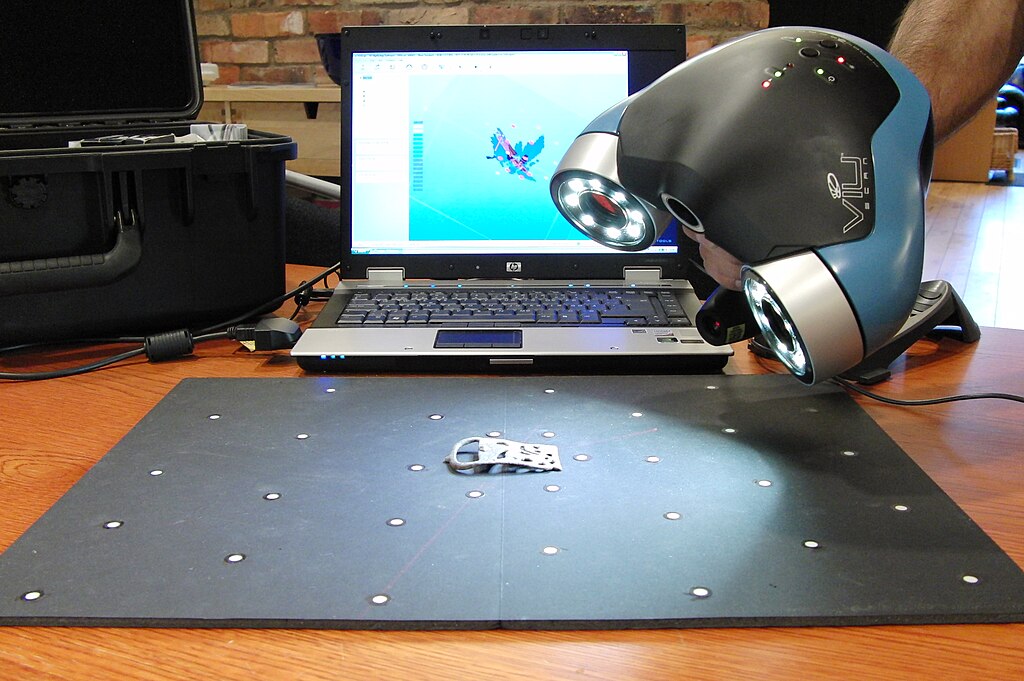
Advances in technology have revolutionized the study of dinosaur trackways, allowing for unprecedented precision in analyzing potential stampede evidence. Light Detection and Ranging (LiDAR) scanning, photogrammetry, and 3D modeling now enable researchers to document entire trackway surfaces at submillimeter resolution, preserving details that might be missed by traditional photography or casting methods. These techniques reveal subtle features like skin impressions, claw marks, and pressure pads that provide insights into dinosaur foot anatomy and weight distribution during movement. At sites like the Al Wabra trackways in Qatar, researchers have used ground-penetrating radar to identify dinosaur footprints beneath the surface, revealing previously unknown stampede patterns without destructive excavation. Digital preservation also allows for sophisticated statistical analysis of hundreds or thousands of footprints simultaneously, helping scientists identify patterns in movement direction, speed changes, and group dynamics that might indicate coordinated responses to threats.
Lesser-Known Stampede Sites Around the World

While famous locations like Lark Quarry often dominate discussions of dinosaur stampedes, numerous less publicized sites worldwide contribute valuable data to our understanding of these dramatic events. The Zhucheng trackways in China’s Shandong Province preserve evidence of hadrosaur herds moving rapidly in a consistent direction, with some footprints showing the characteristic deep heel impressions and elongated toe marks associated with running. In Bolivia, the Cal Orcko site contains over 5,000 dinosaur tracks, including several parallel trackways of titanosaur sauropods that appear to show coordinated movement in response to a threat along what was once a lakeshore. Morocco’s Agadir-Atlas Mountains region has yielded trackways showing apparent ornithopod stampedes dating to the Middle Jurassic, significantly earlier than many other known examples. The Fumanya tracksite in Spain preserves evidence of titanosaur sauropods moving in apparent haste, with unusually long strides suggesting rapid movement of dinosaurs previously thought to be strictly slow-moving. These diverse sites demonstrate that stampede behavior occurred across multiple dinosaur lineages and throughout the Mesozoic era.
Implications for Understanding Dinosaur Social Intelligence

The coordinated movements preserved in stampede trackways provide compelling evidence for sophisticated social intelligence among many dinosaur species. The ability to respond collectively to threats requires advanced communication systems and social awareness beyond what was once attributed to reptilian brains. Trackways showing consistent spacing between individual, even during high-speed movement, suggest dinosaurs maintained awareness of group members’ positions while fleeing—a cognitive skill previously associated primarily with mammals and some birds. Evidence of protective formations, with adults positioning themselves between younger individuals and potential threats, indicates altruistic behavior and recognition of vulnerability differences within the herd. Some trackways even suggest dinosaurs may have returned to check on fallen herd members, with footprints showing circular paths around areas where deeper, chaotic impressions indicate an animal may have stumbled. These behavioral insights fundamentally challenge earlier views of dinosaurs as solitary, simple-minded creatures and align more closely with our understanding of their avian descendants’ cognitive capabilities.
Future Directions in Stampede Research
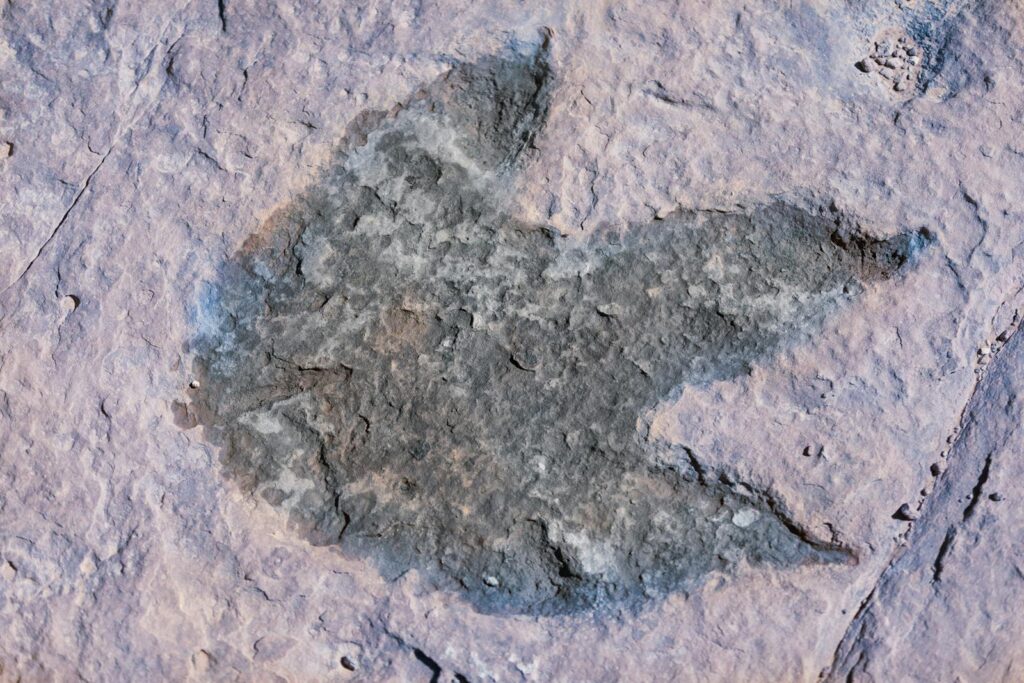
The study of dinosaur stampedes continues to evolve, with several promising research directions emerging in recent years. Advanced computer modeling now allows paleontologists to simulate dinosaur movement patterns using principles from fluid dynamics and crowd behavior theory, helping to distinguish between different interpretations of trackway evidence. Geochemical analysis of sediments surrounding trackways can reveal environmental conditions at the time footprints were made, potentially identifying triggers for mass movements like sudden climate shifts or volcanic activity. Comparative studies examining modern animal stampedes using drone footage and GPS tracking provide new reference points for interpreting fossil evidence. Some researchers are developing machine learning algorithms to analyze thousands of individual footprints simultaneously, identifying subtle patterns human observers might miss. As excavations continue worldwide, new stampede sites will undoubtedly be discovered, especially in underexplored regions of Asia, Africa, and South America, potentially revealing how stampede behavior varied across different dinosaur ecosystems and periods.
Conclusion
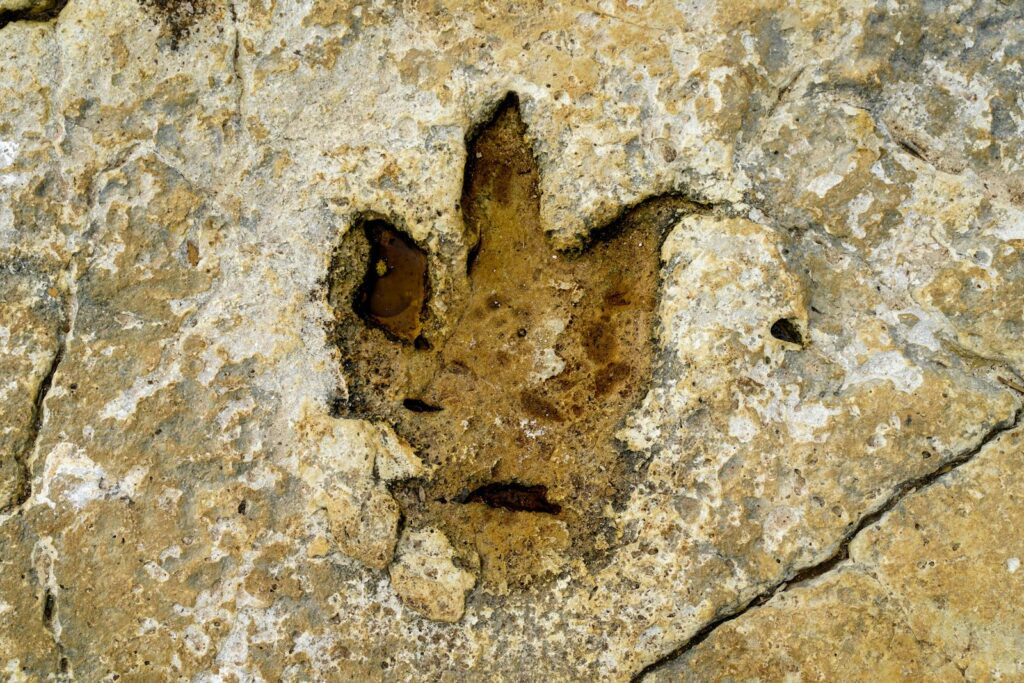
The fossil footprints preserving ancient dinosaur stampedes offer unique and irreplaceable insights into prehistoric behavior impossible to glean from skeletal remains alone. These momentary glimpses of dinosaur panic, preserved for millions of years, reveal sophisticated social structures, coordinated group responses, and protective behaviors that challenge traditional views of dinosaur intelligence. While interpretation challenges remain, with ongoing debates about distinguishing true stampedes from normal movements, technological advances continue to refine our understanding of these remarkable trace fossils. As research progresses, dinosaur stampede evidence increasingly bridges the gap between fossilized remains and living animals, transforming our perception of dinosaurs from static museum exhibits to dynamic, socially complex creatures navigating the dangers of their ancient world. In these fossilized moments of flight, we find perhaps the most vivid connection to dinosaurs not as extinct monsters, but as animals responding to their environment in ways recognizable to anyone who has observed the natural world today.


